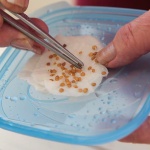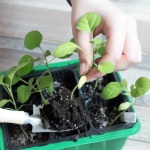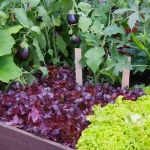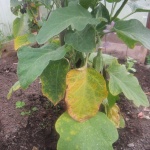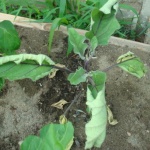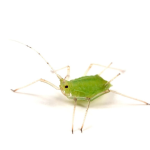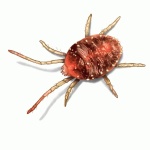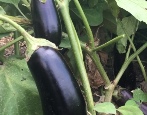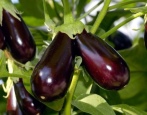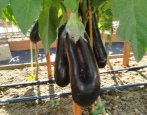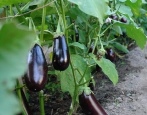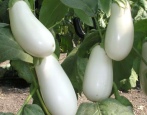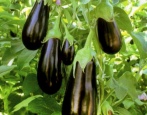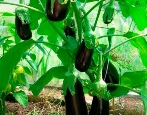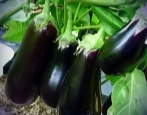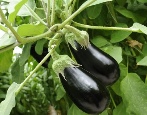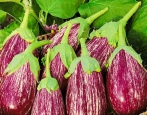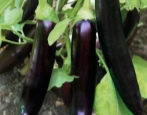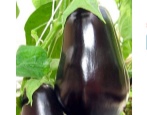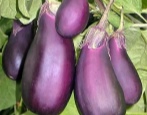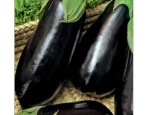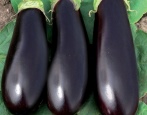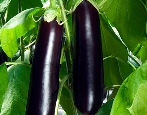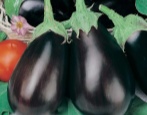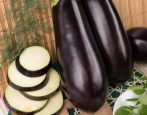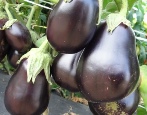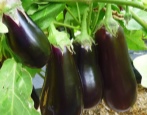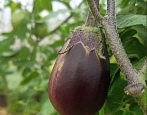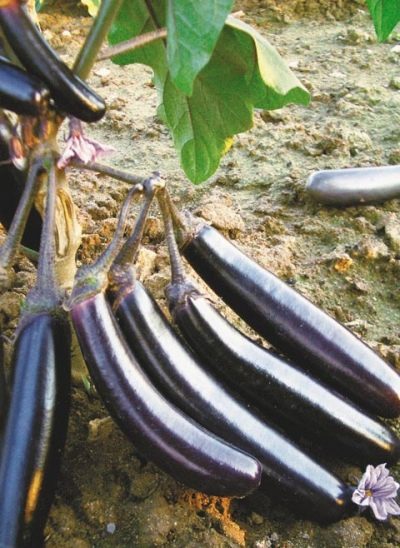
- Growth type: medium-sized
- Bush height, cm: 40-150
- Fruit shape: elongated
- Yield: high yielding
- Fruit color: dark purple
- Ripening terms: early
- Pulp (consistency): gentle
- Color of the pulp: white
- The period from germination to harvest: 95-105
- Taste : no bitterness
Eggplant is considered a thermophilic and difficult crop to grow. However, there are varieties that do not meet these criteria at all. One of these was the King of the North - a cold-resistant variety that does not require close attention of summer residents.
Description of the variety
The King of the North is one of the best breeding achievements. This young variety has already been tested by thousands of summer residents, and this is what they say about it:
- frost-resistant eggplant, can be cultivated in areas of extreme farming;
- plants give a large number of beautiful glossy fruits with delicate pulp;
- belonging to the hybrid type indicates that the plant is much better at resisting diseases than its varietal counterparts;
- this is one of the earliest varieties;
- the cultivation of the King of the North can be equally fruitful both in the open air and in a greenhouse;
- the culture does not require scrupulous care, giving the summer resident time for more capricious plants.
When growing this variety, you need to take into account only two negative points:
- fruits are long in shape, they often sink directly to the soil and become contaminated;
- there is no way to collect seeds, since the King of the North is a hybrid.
Characteristics of the appearance of plants and fruits
The height of the bushes of the variety is different: there are both tall and medium-sized specimens. Everything depends on the place of growth. In the open field, bushes will grow 40-70 cm high, and in greenhouses they can reach a mark of one and a half meters.
An interesting feature of the King of the North is its stems: they are very powerful and are colored in a bright purple tone. The foliage is not particularly large, wrinkled. Her color is emerald, but the veins are the same color as the stems. The plant blooms beautifully, with delicate lilac flowers.
The fruits of this variety look very unusual. Unlike the usual barrel-shaped pot-bellied eggplants, these are longer, thinner, about 30 centimeters in length. Thanks to this feature, they often lie on the ground, which should not be allowed in order to avoid rotting. The dark purple, thin-skinned fruits weigh about 300-350 grams each.
If the proper conditions are provided (+ 1-2 degrees and humidity at 90%), then the eggplants can lie for a whole month. An added bonus for gardeners is the fruit's ability to easily overcome trips. Therefore, such eggplants may well be cultivated for sale.
Purpose and taste
The King of the North has a very tender and juice-rich pulp, which has no veins. Eggplant can be used in any type of cooking. They are fried in a pan, baked in the oven or on the grill, and used in the preparation of caviar. From the long fruits of the variety, wonderful "boats" with delicious filling, amazing dressings, rolls, salads are obtained. You can also freeze vegetables for the winter by cutting them into pieces.
Ripening terms
The early King of the North needs only 95-105 days to produce the first harvest. It will bear fruit for a long time, about two months. If the variety is grown in the open field, then the fruits can be harvested until the end of summer, and if in a greenhouse, then until the end of September.
Yield
Eggplant with the northern name is considered to be very high-yielding.Each bush forms up to 12 fruits, which is a worthy indicator. With minimal care, 15 kg of vegetables are harvested from a square meter of beds, and with increased care - 22 kg.
Growing regions
The King of the North can be grown in any of the regions of the Russian Federation.
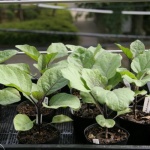
To get a tasty and bountiful eggplant crop, you must first grow strong and healthy seedlings. This culture is considered very capricious, therefore, you need to take care of seedlings when growing at home as correctly and carefully as possible.
Landing scheme
The correct distance between the eggplant bushes is 40 centimeters. If we are talking about the aisles, then their width is 70 cm.
Growing and caring
In the second half of February, summer residents of the southern regions can already start sowing seeds for seedlings. In the north, this is best done in early March. The grains are prepared for planting, and then placed in containers with independently prepared or purchased substrate. Seedlings are grown as standard, care for the King of the North will be the same as for any other seedlings. In May or June (depending on the initial planting date), young plants can be planted in a permanent place.
This variety is very hardy and takes root very quickly in the soil. But so that the survival rate was one hundred percent, two days before planting, the bushes are sprayed with "Heteroauxin", spending 2 milliliters of funds for a bucket of water. When planting a crop, you should remember 2 basic rules:
- plants are transferred to the soil directly with an earthen clod;
- 5 bushes are placed on a square meter as much as possible.
Planting holes before placing the bushes there are poured with three liters of water. This is enough for the eggplants to feel comfortable and do not require liquid for a week after planting. In addition, the bushes shade from the aggressive daytime sun for the first 14 days.
A week after planting, young bushes can be watered. Then they are watered every three days, provided a comfortable summer without excessive heat and drought. If the warm season turned out to be too hot (above 30 degrees), then watering should be carried out daily, preferably in the morning. Lack of water will make the fruits of the King of the North bitter and less juicy. At least 2 liters of warm liquid are spent on each bush.
What else should you pay attention to:
- water the King of the North with water that has previously settled;
- the flow of liquid should go to the root, sprinkling is contraindicated;
- after a few hours, you need to fluff the soil and weed it;
- mulch is a great help for keeping moisture, but it will need to be renewed several times per season (in addition, it protects the fruits that fall to the ground from dirt and rot).
The King of the North loves feeding very much, and it will have to be fed once every 14 days. The first time is fertilized 2 weeks after planting, with nitrophosphate. Top dressing can be repeated until flowering begins. Or replace it with useful organic matter if you don't want chemistry. For example, dandelion or nettle infusion, mullein. After feeding, they wait half an hour and water is carried out.
When the eggplant bushes bloom, the nitrogen supply is completely stopped, replacing it with wood ash or commercial fertilizers with phosphorus and potassium.
Important: only bushes growing in greenhouses need such a procedure as a garter. Those that are in the open ground are too small in stature, and their fruits are concentrated in the lower part.
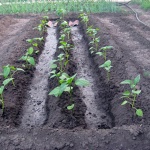
Planting eggplant is one of the most important stages in growing. When choosing a place for eggplants in your area, it is important to remember that this culture should be in warm soil, constantly illuminated by the sun. The plant is also very fond of spacious, open spaces, since its roots can grow over sufficient areas.


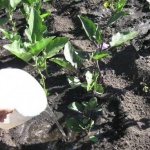
Soil requirements
The King of the North grows on light soils. The soil must be nutritious and have a loose structure. The best solution is loam with neutral acidity. It is worth noting that it is also prepared in the fall: humus, ash, mineral dressings are added.
Required climatic conditions
Eggplants are planted in sunny places, temporarily shading young seedlings. The King of the North variety is practically indifferent to cold weather, it also tolerates heat well. But the wind will be a big problem for him. If there are no trees on the site, some gardeners even have to erect artificial walls to protect the bushes.
Disease and pest resistance
The King of the North demonstrates good health, and his immunity is enough to cope with fungi and viruses. If you treat the seeds before planting, then the probability of getting sick is zero. Additional protection measures will be provided by mulch and one- or two-time treatment with "Fitosporin". But aphids, slugs and spider mites can be inconvenient. The choice of how to deal with them is left to the discretion of the gardener himself.
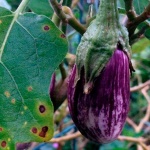
Eggplant is one of the most demanding crops. For its successful cultivation, it is necessary to create optimal conditions, as well as to carry out prevention and fight against diseases and pests. Eggplant often infects both fungal and viral diseases. If treatment is not started on time, you can completely lose the crop.
